A series of Statues of the Liberators of western-hemisphere countries from colonial rule is found along Virginia Avenue, N.W., in Washington, D.C. (which has been referred to as a Washington version of New York City's Avenue of the Americas).
Several statues have been erected on Virginia Avenue, N.W., between 18th and 25th Streets, by various Latin American countries honoring their liberators and other national figures. The statues are maintained by the National Park Service. The location on Virginia Avenue was chosen because of its proximity to the headquarters of the Organization of American States (OAS), which is located at Virginia Avenue and 18th Street, and to the Pan American Health Organization (PAHO), which is located at Virginia Avenue and 23rd Street.
Ordered going from East to West:
The statue of Gálvez was given by Juan Carlos I of Spain to the United States in celebration of the Bicentennial of American Independence in 1976. Galvez was selected as the subject of the statue because Spain was an ally of the American colonies in the Revolutionary War against the British. Galvez led an army that waged a successful campaign against the British along the Gulf Coast during the war.
The statue of Benito Juarez relates to the reforms made by him to control power from the Church in México. The Libertator of México is actually Miguel Hidalgo y Costilla. México was the first country to fight against the Spanish Kingdom. Hidalgo was the first one to start the Liberty movement in Latin America.
In the year 1972, the statue of San Martín was removed to its present location from Judiciary Square (roughly E Street between 4th and 5th Streets, NW), where it had been erected in 1925 at a ceremony including President Calvin Coolidge. This move was necessitated by the construction of the Washington Metro station at Judiciary Square. The statue is a copy of the statue of San Martín that stands in Buenos Aires' Plaza San Martín (sculpted in 1862 by French artist Louis-Joseph Daumas).
Another related statue is of Don Quixote de La Mancha, which is located on the grounds of the John F. Kennedy Center for Performing Arts. It was sculpted by Aurelio Teno, the Don Quixote statue was also presented by Juan Carlos I of Spain, along with the Gálvez statue, on his 1976 visit to the United States.

Dupont Circle is a historic roundabout park and neighborhood of Washington, D.C., located in Northwest D.C. The Dupont Circle neighborhood is bounded approximately by 16th Street NW to the east, 22nd Street NW to the west, M Street NW to the south, and Florida Avenue NW to the north. Much of the neighborhood is listed on the National Register of Historic Places. However, the local government Advisory Neighborhood Commission and the Dupont Circle Historic District have slightly different boundaries.

Farragut Square is a city square in Washington, D.C.'s Ward 2. It is bordered by K Street NW to the north, I Street NW to the south, on the east and west by segments of 17th Street NW, and interrupts Connecticut Avenue NW. It is the sister park of McPherson Square two blocks east. It is serviced by two stops on the Washington Metro rail system: Farragut North on the Red Line and Farragut West on the Blue, Orange, and Silver Lines.

Embassy Row is the informal name for a section of Northwest Washington, D.C., with a high concentration of embassies, diplomatic missions, and diplomatic residences. It spans Massachusetts Avenue N.W. between 18th and 35th street, bounded by Scott Circle to the south and the United States Naval Observatory to the north; the term is often applied to nearby streets and neighborhoods that also host diplomatic buildings, such as Kalorama.
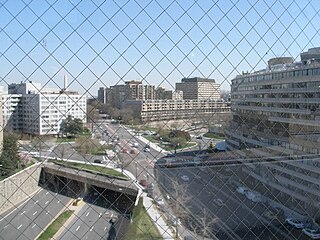
Virginia Avenue is a street in the Northwest, Southwest, and Southeast quadrants of Washington, D.C. Like other state-named streets in Washington, it diagonally crosses the grid pattern formed by lettered (east-west) and numbered (north-south) streets.

There are many outdoor sculptures in Washington, D.C. In addition to the capital's most famous monuments and memorials, many figures recognized as national heroes have been posthumously awarded with his or her own statue in a park or public square. Some figures appear on several statues: Abraham Lincoln, for example, has at least three likenesses, including those at the Lincoln Memorial, in Lincoln Park, and the old Superior Court of the District of Columbia. A number of international figures, such as Mohandas Gandhi, have also been immortalized with statues. The Statue of Freedom is a 19½-foot tall allegorical statue that rests atop the United States Capitol dome.
National Mall and Memorial Parks is an administrative unit of the National Park Service (NPS) encompassing many national memorials and other areas in Washington, D.C. Federally owned and administered parks in the capital area date back to 1790, some of the oldest in the United States. In 1933, they were transferred to the control of the National Park Service. These parks were known as the National Capital Parks from their inception until 1965. The NPS now operates multiple park groupings in the D.C. area, including National Capital Parks-East, Rock Creek Park, President's Park, and George Washington Memorial Parkway. National Mall and Memorial Parks also provides technical assistance for the United States Navy Memorial.

An equestrian statue of Venezuelan military and political leader Simón Bolívar by the American artist Felix de Weldon is located in Washington, D.C., at Virginia Avenue NW, 18th Street NW, and C Street NW, near the United States Department of Interior and the Pan American Union Building of the Organization of American States. It was surveyed as part of the Smithsonian Institution's Save Outdoor Sculpture! survey in 1993.

The General Jose de San Martin Memorial is an equestrian statue memorial of Argentine general and independence leader José de San Martín in Washington, D.C., United States.

Admiral David G. Farragut is a statue in Washington, D.C., honoring David Farragut, a career military officer who served as the first admiral in the United States Navy. The monument is sited in the center of Farragut Square, a city square in downtown Washington, D.C. The statue was sculpted by female artist Vinnie Ream, whose best-known works include a statue of Abraham Lincoln and several statues in the National Statuary Hall Collection. The monument was dedicated in 1881 in an extravagant ceremony attended by President James A. Garfield, members of his cabinet, and thousands of spectators. It was the first monument erected in Washington, D.C., in honor of a naval war hero.

The George Gordon Meade Memorial, also known as the Meade Memorial or Major General George Gordon Meade, is a public artwork in Washington, D.C. honoring George Meade, a career military officer from Pennsylvania who is best known for defeating General Robert E. Lee at the Battle of Gettysburg. The monument is sited on the 300 block of Pennsylvania Avenue NW in front of the E. Barrett Prettyman United States Courthouse. It was originally located at Union Square, but was removed and placed in storage for fourteen years before being installed at its current location. The statue was sculpted by Charles Grafly, an educator and founder of the National Sculpture Society, and was a gift from the state of Pennsylvania. Prominent attendees at the dedication ceremony in 1927 included President Calvin Coolidge, Governor John Stuchell Fisher, Secretary of the Treasury Andrew W. Mellon, and Senator Simeon D. Fess.

Lieutenant General George Washington is an 1860 equestrian statue of George Washington, at Washington Circle, at the edge of the George Washington University's campus, in Washington, D.C. The statue was sculpted by Clark Mills, who also created the equestrian statue of Andrew Jackson in front of the White House. The traffic circle where the statue is located was one of the original city designs by Pierre Charles L'Enfant. The statue and surrounding park are in the Foggy Bottom neighborhood at the intersection of 23rd Street, New Hampshire Avenue, and Pennsylvania Avenue NW. The K Street NW underpass runs beneath the circle.

Brevet Lt. General Winfield Scott is an equestrian statue in Washington, D.C., that honors career military officer Winfield Scott. The monument stands in the center of Scott Circle, a traffic circle and small park at the convergence of 16th Street, Massachusetts Avenue and Rhode Island Avenue NW. The statue was sculpted by Henry Kirke Brown, whose best-known works include statues of George Washington in New York and Nathanael Greene in Washington, D.C. It was the first of many sculptures honoring Civil War generals that were installed in Washington, D.C.'s traffic circles and squares and was the second statue in the city to honor Scott.

The statue of John Aaron Rawlins, a United States Army general who served during the Civil War and later as Secretary of War, is a focal point of Rawlins Park, a small public park in Washington, D.C.'s Foggy Bottom neighborhood. It was installed in 1874, but relocated several times between 1880 and 1931. The statue was sculpted by French-American artist Joseph A. Bailly, whose best known work is the statue of George Washington in front of Independence Hall in Philadelphia.
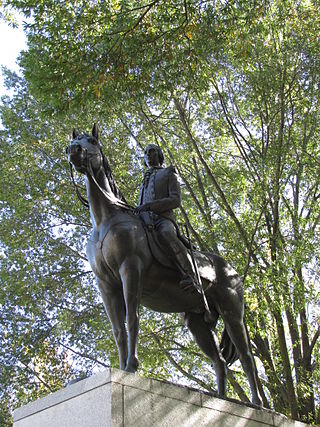
Bernardo de Gálvez is a bronze equestrian statue of Bernardo de Gálvez, 1st Viscount of Galveston, sculpted by Juan de Ávalos of Spain.
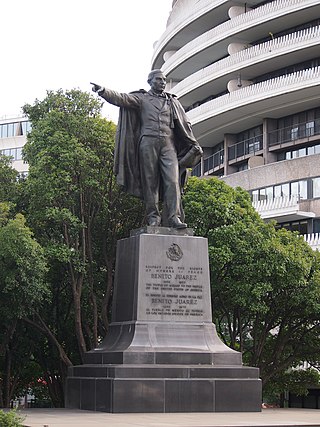
Benito Juárez is the title of a work of art by Enrique Alciati, located at the intersection of Virginia Avenue and New Hampshire Avenue in Washington, District of Columbia, United States. The statue is a part of the city's Statues of the Liberators collection and is a tribute to former president of Mexico, Benito Juárez.

American Revolution Statuary is a group of 14 statues in Washington, D.C., which honor men whose actions assisted the Thirteen Colonies in their fight against the Kingdom of Great Britain in the American Revolutionary War. They are spread throughout the city, except for the four statues in Lafayette Square, across from the White House, that honor some of the foreign heroes from the war. Some of the statues are located in prominent places, while others are in small parks or stand alone in front of buildings. All of the statues are owned and maintained by the National Park Service, an agency of the United States Department of the Interior. The statuary was collectively listed on the National Register of Historic Places (NRHP) in 1978 and the District of Columbia Inventory of Historic Sites the following year. In addition, most are also contributing properties to historic districts listed on the NRHP.

The Peter Muhlenberg Memorial is a public monument in Washington, D.C. It honors John Peter Gabriel Muhlenberg, a Lutheran minister, Continental Army general, Federalist Era American politician, and member of the prominent Muhlenberg family. The memorial is located in a one-acre park bounded by Connecticut Avenue, Ellicott Street, and 36th Street NW on the eastern edge of Washington's Wakefield neighborhood. Designed by architect John Harbeson, it features at its center a bronze bust of Muhlenberg, sculpted by his descendant, Caroline M. Hufford. Completed in 1980, 52 years after its construction was authorized by Congress, attendees at the dedication ceremony included West German ambassador Peter Hermes.
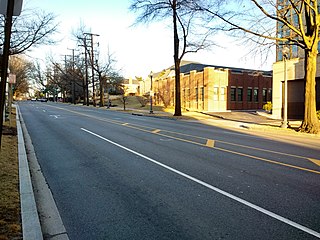
Western Avenue is one of three boundary streets between Washington, D.C., and the state of Maryland. It follows a southwest-to-northeast line, beginning at Westmoreland Circle in the south and ending at Oregon Avenue NW in the north. It is roughly 3.5 miles (5.6 km) in length. First proposed in 1893, it was constructed somewhat fitfully from about 1900 to 1931.

Tomáš Garrigue Masaryk is an outdoor sculpture depicting Tomáš Masaryk, the founding President of Czechoslovakia. It was offered to the United States by the Czech Republic and was inaugurated on Embassy Row on 19 September 2002 in the presence of Czech President Václav Havel, former Slovak President Michal Kováč, and Prague-born former US Secretary of State Madeleine Albright.
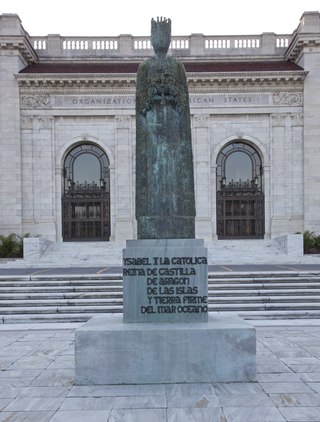
Queen Isabella, also known as Queen Isabella (1451–1504), is an outdoor sculpture of Isabella I of Castile, installed outside the Pan American Union Building of the Organization of American States at 17th Street and Constitution Avenue NW in Washington, D.C., in the United States.



















